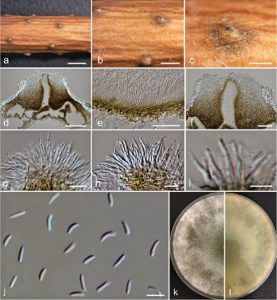Cytospora longiostiolata Norphanphoun, Bulgakov, T.C. Wen & K.D. Hyde, sp. nov., Index Fungorum number: IF552605
Etymology: The specific epithet ‘longiostiolata’ refers to the long ostiolate of conidiomata.
Holotype: MFLU 15-3784
Associated with twigs and branches of Salix × fragilis L. [S. alba L. × S. euxina I.V. Belyaeva]. Sexual morph: Undetermined. Asexual morph: Conidiomata 880–1000 × 480–600 μm diameter, semi-immersed in host tissue, solitary, erumpent, discoid, circular to ovoid, unilocular, with long ostiolar neck with ratio of conidiomata (3:4). Ostioles 400–500 μm diameter, at the same level as the disc surface. Peridium comprising several layers of cells of textura angularis, with inner most layer thin, pale brown, outer layer brown. Conidiophores unbranched or occasionally branched at the base, reduced to conidiogenous cells. Conidiogenous cells blastic, enteroblastic, phialidic, formed from the inner most layer of pycnidial wall, hyaline, smooth-walled. Conidia (3.9–)5.4–6.6 ×1.0–1.2(–1.5) μm (x̅ = 5.5 × 1.3 μm, n = 30), unicellular, allantoid to subcylindrical, hyaline, smooth-walled.
Culture characteristics: Colonies on MEA, reaching 9 cm diameter after 7 days at 25 °C, producing dense mycelium, circular, margin rough, white, with aerial mycelium.
Material examined: RUSSIA, Rostov Region, Krasnosulinsky District, Donskoye forestry, spinney ravine, on dying twigs and branches of Salix × fragilis L. [S. alba L. × S. euxina I.V. Belyaeva] (Salicaceae), 27 October 2015, T. Bulgakov, T-1122 (MFLU 15-3784, holotype, KUN, isotype), ex-type living culture, MFLUCC 16-0628, KUMCC.
Notes: Cytospora longiostiolata is introduced as new species base on morphological characters and phylogenetic analyses. It has unilocular conidiomata with long ostioles. Phylogenetic analysis using ITS sequence data showed that C. longiostiolata is closely related to C. salicina (MFLUCC 15-0862, MFLUCC 16-0637) and C. chrysosperma species (Fig. 1). However, C. salicina (4.8 × 1.1 μm) and C. chrysosperma (4.6 × 1.2 μm) differ from C. longiostiolata (5.5 × 1.3 μm) in having multiloculate conidiomata with smaller conidia. In the phylogenetic analyses based on combined ITS, LSU, RPB2 and ACT sequence data, C. longiostiolata forms a single lineage, separate from these taxa with high bootstrap support (93% ML/ 1.00 PP).
Cytospora longiostiolata was collected from Salix and is most similar to C. curvata and the differences are discussed under the species C. curvata. The species also resembles C. donetzica in conidia size (C. longiostiolata: 5.5 × 1.3 versus 5.5 × 1.4 μm: C. donetzica). However, C. donetzica differs C. longiostiolata in having 3–4 locules conidiomata and shorter ostiolar necks (150–250 μm).
In ITS, Cytospora longiostiolata differs from C. chrysosperma with two polymorphisms, with C. salicina in five polymorphisms. In RPB2 it differs with 21 polymorphisms from C. chrysosperma, 19 polymorphisms from C. salicina. In ACT it differed in 11 polymorphisms from C. chrysosperma and 11 polymorphisms from C. salicina.
FIG: Cytospora longiostiolata on Salix × fragilis (MFLU 15-3784, holotype). a Stromatal habit in wood. b Fruiting bodies on substrate. c Surface of fruiting bodies. d Cross section of the stroma showing conidiomata. e Peridium. f Ostiolar neck. g–i Conidiogenous cells with attached conidia. j Mature conidia. k, l Colonies on MEA (k-from above, l-from below). Scale bars: a = 2000 μm, b = 1000 μm, c = 500 μm, d = 200 μm, e = 20 μm, f = 100 μm, g, h = 10 μm, i, j = 5 μm.

